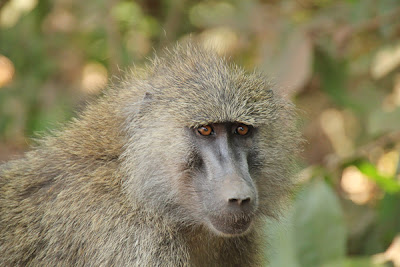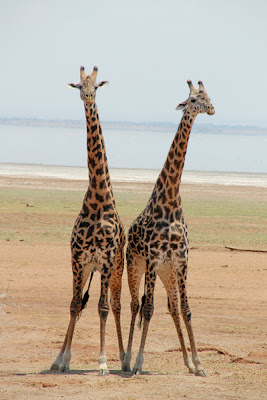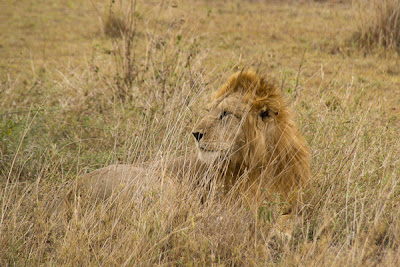This title is in fact not a poor attempt at a play off of The Lion King. Rather, “simba” means lion in Swahili. Considering my nearly unhealthy obsession with this great African beast and our good fortune in recently seeing twenty lions in the wild I thought that it was an appropriate title for this post. A week ago I embarked on an incredible four day journey in search of nyama or wildlife in three of Tanzania's fourteen national parks. Tanzania is blessed with an abundance of wildlife and nearly untouched natural habitats. While this is somewhat due to the fact that Tanzania's population is small relative to its size, the preservation on these lands has a lot to do with British colonialism and a German conservationist by the name of Bernhard Grizimek. Because of early conservation efforts and continued conservation work by international researchers and local authorities, some of the world's most incredible wildlife still thrives. Most notably, the “great migration” in the Serengeti still thrives. It is an incredible cycle where a quarter million zebra and a half million wildebeest make the annual migration between the north and the south of the Serengeti ecosystem which spans both part of Tanzania and Kenya. Though we only caught the early part of the migration in the part of the Serengeti that we explored, the various evolutionary strategies caused by the predator-prey relationship were incredible to experience.
Lake Manyara

Baboon
Tembo
“Tusker”
Two adult twiga on the beach of Lake Manyara. We stumbled upon these two as they were performing a mating ritual in which they take turns hitting each other as hard as they can with their necks. Love hurts.
I liked this elephant because I swear he was smiling at us.
Impala
A pair of monkeys in a tree
A young baboon
Tarangire
A tembo family sticks together. Elephants don't have a care in the world as they walk around with heavy feet, eating and breaking down tree branches as they pass. Full grown elephants don't have to worry about predation because of their size, but consequentially they must eat a lot to stay alive.
The remains of a giraffe laying on the ground in the park. The park service does not disturb the natural cycles by removing animal carcasses so that as the remains degrade the nutrients remain in the ecosystem.
Tembo means elephant in swahili. The verb “to walk” is kutembia. I have to imagine that the close association between the verb and the the name of the big walker is not a coincidence.
These birds and the giraffe have a symbiotic relationship in which the birds eat parasites off of the giraffe.
Two pumba (warthogs) sleeping under a tree during the hot day. Once again the inspiration for The Lion King comes to mind.
Mama and child, two monkeys hang out in a tree. The younger monkey looks with curiosity at the funny looking white people with cameras.
Nyani
I took this series of monkey pictures at the lunch stop in Tarangire. Monkeys flock to the area in search of food. If you are not careful they will steal your sandwich or even your camera. Apparently they have learned to seek out white people as the African tour guides throw rocks to scare them away.
Lion food
A young, awkward looking giraffe that stood curiously nearby our vehicle
Water is life. We watched as a small pack of zebras descended the river bank to drink from a shallow river. During the rainy season this river is overflowing and wildlife flocks to its banks. In the few months before the heavy rains the river dries up completely in some areas.
An elephant family walks away carelessly. Parents must protect their young while they are small, but with little to worry about, life is good.
Serengeti
“I've got your back.” Zebras rest their heads on each other and stand in opposite directions keeping a watchful eye on the tall grass watching for the ever present threat of predators.
Zebras stripes act as a defense mechanism. Predators pick out their prey and carefully calculate the distance before they attack. Zebras weave amongst the pack in order to confuse the predator with an array of stripes.
The Crowned Crane, the national bird of Uganda
Notice that all the leaves on this tree are at the top of the branches. Evolution plays a big role in the development of traits in plants as well as animals. This particular tree has adapted to grow out of the reach of giraffes.
A chui (leopard) sleeps away the day before a long night of hunting.
Simba
The female lion points as she scans the horizon for prey. A lion pride typically consists of one male and a handful of females. The male protects the pride and must fight off other males for the right to the females and the females hunt together for food. After the females have killed their prey the male gets to eat first. This relationship is not so different from Tanzania families where women cook and clean and men eat the choice part of the meal.
The male lion wakes after a long sleep. Lions sleep between sixteen and twenty hours per day.
The male watches as the females spread out and search for prey.
The bearded wildebeest
A young male relaxes under a tree. We stumbled up him just as he was waking from his sleep.
Ndege is the Swahili word for both bird and airplane.
More lion food
A hot air balloon floats over the Serengeti in the early hours of the morning.
A cheetah, the fastest predator in the Serengeti
While cheetahs are fast, they are also meek in nature. Hyenas follow close behind cheetahs. When cheetahs kill prey they must eat quickly as hyenas are quick to close in and scare them away. Cheetahs therefore start by eating the hind legs because they contain the most protein.
Ngorongoro
A view of the Ngorongoro Crater from the highlands
A zebra grazes on the low grasses of the Gorongoro Crater.
Life as a predator is not easy. Lions must save their energy as they may go a few days without eating.
This picture gives you an idea of how flat and open the crater is. The landscape is quite different than the Serengeti, Tarangire, or Manyara.
This female lion wakes from sleeping in a tree. Immediately she is alert and on the hunt for prey. Trees and rocks offer good perches where lions can sit and hide from prey as they wait to attack.







































